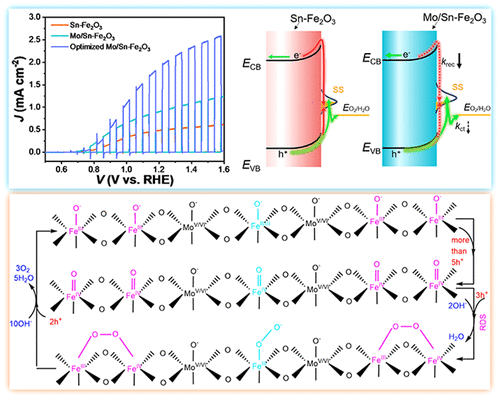当前位置:
X-MOL 学术
›
ACS Appl. Energy Mater.
›
论文详情
Our official English website, www.x-mol.net, welcomes your
feedback! (Note: you will need to create a separate account there.)
Simultaneously Enhanced Charge Separation and Transfer in Cocatalyst-Free Hematite Photoanode by Mo/Sn Codoping
ACS Applied Energy Materials ( IF 5.4 ) Pub Date : 2021-09-17 , DOI: 10.1021/acsaem.1c02291 Jingran Xiao 1 , Borui Du 1 , SiYuan Hu 1 , Jun Zhong 1 , Xingyu Chen 1 , Yanghong Zhang 1 , Dongren Cai 1 , Shu-Feng Zhou 1 , Guowu Zhan 1
ACS Applied Energy Materials ( IF 5.4 ) Pub Date : 2021-09-17 , DOI: 10.1021/acsaem.1c02291 Jingran Xiao 1 , Borui Du 1 , SiYuan Hu 1 , Jun Zhong 1 , Xingyu Chen 1 , Yanghong Zhang 1 , Dongren Cai 1 , Shu-Feng Zhou 1 , Guowu Zhan 1
Affiliation

|
It is well-known that sluggish surface charge transfer on a cocatalyst-free hematite photoanode limits its solar conversion efficiency in photoelectrochemical (PEC) water splitting. Here, Mo is used as a codopant synergistically with Sn in α-Fe2O3 to solve this problem. Besides causing a slight narrowing of bandgap, morphological change, and even sublimation loss of α-Fe2O3, Mo doping also imports low-valent Fe due to charge compensation with MoV/VI as indicated by X-ray photoelectron spectroscopy and Bader charge computation, which increases the densities of donor and surfaces states. Although rate law analysis demonstrates slight retardation of surface reaction kinetics, strongly inhibited charge recombination in surface states by Mo doping still contributes to improving the photocurrent density and reducing the onset potential of α-Fe2O3 and Sn–Fe2O3 photoanodes. An optimized Mo/Sn–Fe2O3 photoanode can realize a low onset potential of 0.68 V vs a reversible hydrogen electrode (VRHE) and a photocurrent density of 1.97 mA cm–2 at 1.23 VRHE, enhanced by 58% and 20 times compared to Sn–Fe2O3 and α-Fe2O3, respectively. It is demonstrated that Mo doping promotes charge transfer which differs from most traditional n-type dopants that facilitate charge separation but inhibit charge transfer. This report expands the n-type dopant family of α-Fe2O3 for efficient PEC water splitting.
中文翻译:

通过 Mo/Sn 共掺杂同时增强无助催化剂赤铁矿光阳极中的电荷分离和转移
众所周知,无助催化剂的赤铁矿光阳极上缓慢的表面电荷转移限制了其在光电化学(PEC)水分解中的太阳能转换效率。在此,Mo与α-Fe 2 O 3 中的Sn协同用作共掺杂剂以解决该问题。除了引起α-Fe 2 O 3的带隙略微变窄、形态变化甚至升华损失外,Mo掺杂还通过Mo V/VI电荷补偿引入低价Fe如X射线光电子能谱和Bader电荷计算所示,这增加了施主和表面态的密度。尽管速率定律分析表明表面反应动力学略有延迟,但通过 Mo 掺杂强烈抑制表面态的电荷复合仍然有助于提高光电流密度并降低 α-Fe 2 O 3和 Sn-Fe 2 O 3 光阳极的起始电位。优化的 Mo/Sn-Fe 2 O 3 光阳极相对于可逆氢电极 (V RHE )可实现 0.68 V 的低起始电位和1.23 V RHE下的 1.97 mA cm –2光电流密度,分别比 Sn-Fe 2 O 3和 α-Fe 2 O 3提高了 58% 和 20 倍。结果表明,Mo 掺杂促进电荷转移,这与大多数传统的 n 型掺杂剂不同,后者促进电荷分离但抑制电荷转移。该报告扩展了 α-Fe 2 O 3的 n 型掺杂剂家族,以实现高效的 PEC 水分解。
更新日期:2021-09-27
中文翻译:

通过 Mo/Sn 共掺杂同时增强无助催化剂赤铁矿光阳极中的电荷分离和转移
众所周知,无助催化剂的赤铁矿光阳极上缓慢的表面电荷转移限制了其在光电化学(PEC)水分解中的太阳能转换效率。在此,Mo与α-Fe 2 O 3 中的Sn协同用作共掺杂剂以解决该问题。除了引起α-Fe 2 O 3的带隙略微变窄、形态变化甚至升华损失外,Mo掺杂还通过Mo V/VI电荷补偿引入低价Fe如X射线光电子能谱和Bader电荷计算所示,这增加了施主和表面态的密度。尽管速率定律分析表明表面反应动力学略有延迟,但通过 Mo 掺杂强烈抑制表面态的电荷复合仍然有助于提高光电流密度并降低 α-Fe 2 O 3和 Sn-Fe 2 O 3 光阳极的起始电位。优化的 Mo/Sn-Fe 2 O 3 光阳极相对于可逆氢电极 (V RHE )可实现 0.68 V 的低起始电位和1.23 V RHE下的 1.97 mA cm –2光电流密度,分别比 Sn-Fe 2 O 3和 α-Fe 2 O 3提高了 58% 和 20 倍。结果表明,Mo 掺杂促进电荷转移,这与大多数传统的 n 型掺杂剂不同,后者促进电荷分离但抑制电荷转移。该报告扩展了 α-Fe 2 O 3的 n 型掺杂剂家族,以实现高效的 PEC 水分解。











































 京公网安备 11010802027423号
京公网安备 11010802027423号